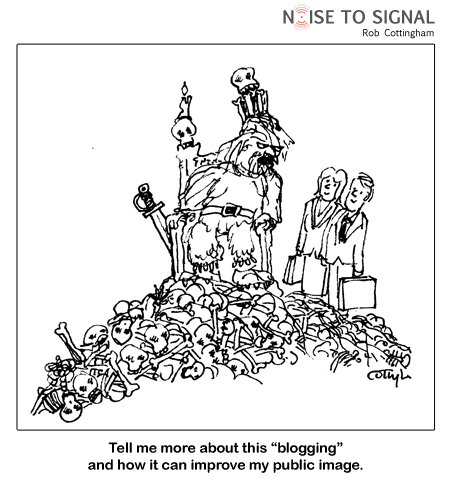- Home
- Blogs
- Rob Cottingham's blog
- 10 ways to maximize your blog's ROI: Part 1, give your organization a human voice
Blog ROI: Put the I in ROI10 ways to maximize your blog's ROI: Part 1, give your organization a human voice
- 9 November, 2008
- 1 comments
Times are tight, which is the polite way of saying that your communications budget has probably been handed to Freddy Krueger for a light trim. So whether your organization is already blogging, or just thinking about it, you need to make a strong case for your blog's ROI.
So over the next few weeks, we're going to look at 10 ways that blogging provides value to your organization - whether it's a company, non-profit, government agency or community group. And we're going to talk about how you can get blogging to go that extra mile for you, and wring out every drop of golden ROI from your posts... while staying true to the principles of authenticity and transparency that give social media so much of their power.
(That may sound like a balancing act - but it actually it isn't. There's no trick to it. It's just a simple trick. Authenticity is actually the engine of the value of blogging, and the relationships and conversations it engenders. But I'm getting ahead of myself...)
So without any further ado, here's blogging's first source of value for your organization:
#1. Blogging lets your organization start communicating with a personal voice, and a human face.
Most organizational communications are impersonal. Vehicles like news releases speak with an institutional voice, and generally it's either flat and emotionless or full of PR hype. Either way, there's no trust and no connection between the communicator and the audience.
Even when individuals do step forward, it's almost always in a scripted way, in speeches, news releases or canned corporate videos. (The exception is when your CFO blurts a few offhand comments to reporters as they're being led away by the police, which - although compelling and humanizing - usually doesn't do a lot for trust either.)
Enter blogging. Whether the blogger is the CEO, an executive director, a senior manager, a frontline employee, a volunteer or even an intern hired expressly to blog, they're going to put a human face on your organization. They'll be talking in a conversational voice and casting your organization's work in the light of their own perceptions and experience.
How does that help you? There's a saying that it's harder to be angrier at a real person than a faceless organization. Now, that isn't exactly true; think of how you felt about your ex right after your last godawful breakup, compared to how you feel about, say, the Owens Corning corporation. But it's fair to say that it's easier to identify with a person than with a faceless organization.
And once that identification has happened, real communication becomes possible.
Here are some ways you can stress the personal on your organizational blog:
- Have one or two people who are the lead bloggers on the site. Let them set the tone, voice and personality of the blog.
- Make sure your bloggers are writing under their own names, not a pseudonym. It's easier to gain trust if you're willing to show a little yourself - and a real name is the least you can offer.
- A thumbnail photo of each post's author can have a big impact. We connect emotionally with faces, even if they're just images.
- Blog with personality and an attitude - in the sense of expressing some kind of emotional reaction to what you're writing about.
- Keep the tone conversational. Passive voice, corporate jargon, financial buzzwords - lose them in favour of plain language. By all means, use appropriate technical terms if you're talking to an audience that uses them too... but ask yourself if this is the kind of language friends might use over coffee (and by coffee, I mean beer).
- Share a little. Hint at having a personal life: pets, hobbies, interests outside of work.
- Understand there are boundaries. Don't overdisclose - chances are any blog post that begins "Wow - I got so trashed last night" isn't going to end well for your or your organization. And don't disclose personal details you wouldn't want splashed all over the web.
You'll know you're getting a good return on this investment in your organization's human face when you see pay-offs like...
- More positive mentions from other bloggers, often referring to your organization's blogger by name - ideally, their first name. For businesses, look especially for mentions associated with purchases of your product; for non-profits, look for references to donating and links to your donation page. In each case, these tell you if there's a link between positive word-of-mouth and actual folding cash money.
- Fewer customer complaints aired on blogs, possibly accompanied by some increase in incoming questions to your bloggers (who will become your first line of defense until you figure out a customer service 2.0 offering).
- More traffic to your site coming from links on other blogs.
In short: be yourself, be professional and be human, and you'll go a long way toward putting the "I" in "ROI".
Work Smarter with Evernote

Get more out of Evernote with Alexandra Samuel's great new ebook, the first in the Harvard Business Press Work Smarter with Social Media series!




Comments
Beth Kanter says